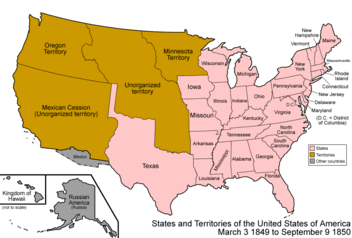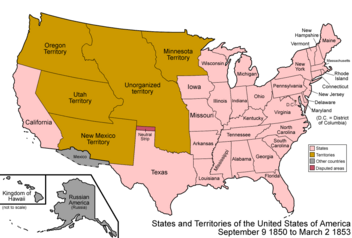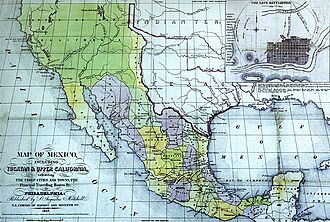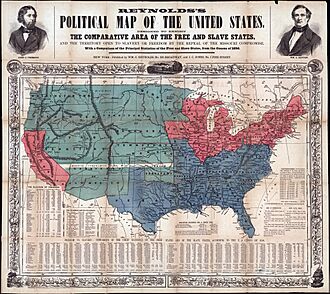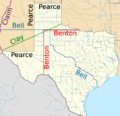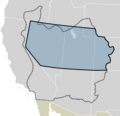Compromise of 1850 facts for kids
The Compromise of 1850 was a group of five laws passed by the United States Congress in September 1850. These laws helped calm arguments between slave and free states for a while, before the American Civil War.
The compromise was designed by senators Henry Clay and Stephen A. Douglas, with help from President Millard Fillmore. It mainly focused on what to do about slavery in the new lands the U.S. had gained from Mexico after the Mexican–American War (1846–48).
Here are the main parts of the Compromise:
- California was allowed to join the U.S. as a free state. This meant slavery was not allowed there.
- The Fugitive Slave Act of 1850 was made stronger. This law made it easier for slave owners to get back enslaved people who had escaped to free states.
- The buying and selling of enslaved people was stopped in Washington, D.C.. However, owning enslaved people was still allowed there.
- Texas's northern and western borders were set. New governments were created for the Territory of New Mexico. People in this territory would decide later if they wanted slavery or not.
- A government was also created for the Territory of Utah. People in Utah would also decide later if they wanted slavery or not.
A big debate about slavery in the new territories started during the Mexican-American War. Many people in the South wanted to expand slavery into these new lands. Many people in the North were against any expansion of slavery. The debate became even more complicated because Texas claimed a lot of land that Mexico also claimed. These disagreements made it hard for Congress to set up governments for the new lands.
In early 1850, Senator Henry Clay suggested a plan to solve these problems. But President Zachary Taylor and other lawmakers disagreed with parts of it. The debates in Congress were very heated. There were even fistfights and drawn guns!
After President Taylor died, Vice President Fillmore became president. Stephen A. Douglas then led the effort to pass Clay's plan as five separate laws. The Compromise of 1850 helped delay the American Civil War.
Contents
Why the Compromise Was Needed
New Lands and Old Problems
The Republic of Texas became independent from Mexico in 1836. Many Americans had settled there, so both Texas and the U.S. wanted Texas to join the United States. In 1845, Texas became the 28th state.
President James K. Polk wanted the U.S. to expand even more. He wanted to get the Mexican area of Alta California. This land offered new places to settle and a way to trade with Asia. Polk tried to buy California from Mexico. But Texas joining the U.S. made Mexico angry. The two countries also argued about the border of Texas. Mexico said the Nueces River was the border, but Texas claimed the Rio Grande was the border.
In March 1846, a small fight broke out near the Rio Grande. This led the United States to declare war on Mexico, starting the Mexican–American War. In August 1846, President Polk asked Congress for money to buy California from Mexico. This started a big debate about whether slavery would be allowed in any new lands.
A new lawmaker, David Wilmot, suggested a plan called the Wilmot Proviso. This plan would ban slavery in any lands gained from Mexico. The Wilmot Proviso did not pass, but it brought the slavery debate right into national politics.
Ending the War and New Debates
In September 1847, an American army captured Mexico City. A few months later, Mexico and the U.S. signed the Treaty of Guadalupe Hidalgo. Mexico agreed that the Rio Grande was Texas's southern border. It also gave up California and New Mexico to the U.S.
The Missouri Compromise of 1820 had decided where slavery could be in the Louisiana Purchase lands. It banned slavery north of a certain line (36°30′ latitude). President Polk wanted to extend this line into the new lands from Mexico. But the issue of slavery was too divisive, and no such law passed. Before his term ended, Polk signed a law creating the Oregon Territory and banning slavery there.
President Polk did not run for re-election. In 1848, Zachary Taylor became president. He was a Whig and also owned enslaved people. Taylor had promised not to stop any law Congress passed about slavery. But he surprised Southerners by saying he wouldn't even stop the Wilmot Proviso if it passed.
Tensions grew quickly. In 1849, the Free Soil Party, which opposed slavery, gained more seats in Congress. This made it hard for the House of Representatives to choose a speaker. Lawmakers argued fiercely, leading to more fistfights and threats. Southern lawmakers even started talking about leaving the United States. Finally, after many votes, Howell Cobb was elected speaker. It was a difficult start to the 1850s.
Key Issues of the Compromise
The Compromise of 1850 dealt with three main types of issues: borders, the status of new territories, and slavery. All these issues were connected to the bigger question of slavery. Both sides cared about how much land would allow slavery and how many states would be free or slave states.
Texas
The independent Republic of Texas won a key battle against Mexico in 1836. Mexico's president signed a treaty recognizing the Rio Grande as Texas's border. But Mexico later said the treaty was signed under force and claimed the Nueces River as the border. A large area between these two rivers was disputed.
When the U.S. annexed Texas in 1845, it took on this border dispute, which led to the Mexican-American War. The Treaty of Guadalupe Hidalgo ended the war and set the new U.S.-Mexico border. But it didn't clearly define the border between Texas and the new lands from Mexico. Texas still claimed a large area of what is now eastern New Mexico.
New Mexico had long banned slavery. Many New Mexicans did not want to join Texas because Texas's capital was far away, and they had a history of conflict. However, many Southern leaders supported Texas's claims to New Mexico. They hoped this would create more land where slavery could expand.
Texas also had about $10 million in debt from its time as an independent nation. This debt became an important part of the debates over the new territories.
California
California was part of the land gained from Mexico. After the Mexican War, military governors mostly ran California. President Polk tried to get Congress to set up a government there, but the arguments over slavery stopped it. Southerners wanted slavery to extend to Southern California and the Pacific Coast, but Northerners did not.
Near the end of Polk's term in 1848, gold was discovered in California! This started the California Gold Rush. California quickly grew from a quiet land to a busy place with many people. The area needed a proper government. Californians wanted to become a territory or state quickly. In 1849, they held a meeting and voted to ban slavery. They did not want to split the state over slavery. The issue of California played a big part in the difficult debates in Congress.
Other Important Issues
Besides the new territories, other issues were causing problems:
- Washington, D.C. Slave Trade: Many Northerners were angry that enslaved people were bought and sold in the nation's capital. They saw it as a stain on the country.
- Fugitive Slaves: Arguments over enslaved people who had escaped grew. The Fugitive Slave Act of 1793 allowed slave owners to get back escaped slaves. But some Northern states passed "personal liberty laws" that made it harder to return alleged escaped slaves.
- Utah: Like California and New Mexico, Utah was also gained from Mexico. It was home to many Latter-day Saints (Mormons). Their practice of polygamy (having more than one spouse) was unpopular in other parts of the U.S.
How the Compromise Passed
President Taylor's Role
When President Taylor took office, the issue of slavery in the new lands from Mexico was still unsettled. Even though Taylor owned enslaved people, he believed slavery would not work well in these new territories. So, he was against slavery there. Taylor thought the best way was to let California become a state right away. This would keep the slavery question out of Congress's hands.
The Gold Rush was happening, and California's population was growing fast. In October 1849, a meeting in California voted to join the U.S. and ban slavery. In December 1849, Taylor told Congress to approve California's and New Mexico's requests for statehood. He asked Congress to avoid "exciting topics of a sectional character" (meaning arguments about slavery).
Key Leaders
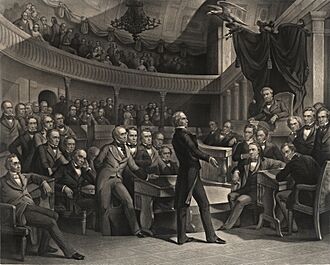
Henry Clay speaks in the Senate; Vice President Millard Fillmore is in charge. John C. Calhoun and Daniel Webster listen.
The problem of what to do with the new territories became the biggest issue in Congress. This led to some of the most famous debates in American history. Three powerful senators led these debates: Henry Clay, Daniel Webster, and John C. Calhoun. They were all born during the American Revolution and were seen as carrying on the ideas of the Founding Fathers. This was their last major political act.
Clay and Webster wanted to find a compromise to keep the country together. Calhoun, who supported the South, warned of disaster. Calhoun was very ill and died soon after. In March, his final speech was read by his friend, Senator James M. Mason. Calhoun warned that the balance between the North and South was broken, and more imbalance could lead to war. The situation was very serious.
Other important politicians who would later play big roles in the Civil War were also involved. These included William H. Seward and Salmon P. Chase, who were against slavery, and Jefferson Davis, who would become president of the Confederate States of America. Stephen A. Douglas, who would later debate Abraham Lincoln, was also a key figure.
Clay's Plan
On January 29, 1850, Senator Henry Clay introduced his plan. It included several proposals:
- California would join as a free state.
- Texas would give up some of its northern and western land claims in exchange for help with its debt.
- New Mexico and Utah territories would be created.
- The sale of enslaved people would be banned in Washington, D.C.
- A stronger fugitive slave law would be passed.
Clay hoped that combining these ideas would make lawmakers from both the North and South support the whole package, even if they disagreed with some parts. Clay's plan gained some support, but not enough to pass right away. The debates continued for seven difficult months.
Opposition and Passage
President Taylor was against Clay's compromise. He still wanted California and New Mexico to become states immediately. Senator Calhoun and other Southern leaders argued that the compromise was unfair to the South because it would create new free states. Most Northern Whigs, led by William Henry Seward, also opposed the compromise. They disliked the idea of slavery expanding into western territories and especially hated that ordinary citizens might have to help catch escaped slaves.
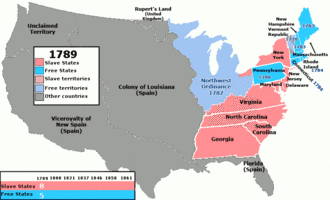
In July 1850, President Taylor died and Millard Fillmore became president. Fillmore secretly supported Clay's plan. The different parts of the compromise were first put into one big bill. But this "omnibus" bill failed to pass. Clay was very tired and sick, so Senator Stephen A. Douglas took over. Douglas decided to try passing each part of the compromise as separate bills.
President Fillmore wanted to quickly solve the border dispute between Texas and New Mexico, which was close to becoming a fight. He supported the compromise measures. Fillmore also said that the U.S. would protect New Mexico's land. This helped convince Texas's senators, Sam Houston and Thomas Jefferson Rusk, to support Douglas's plan.
With their support, a bill settling Texas's borders passed the Senate. Under this bill, the U.S. would pay Texas's debts. Texas's northern border was set at the 36° 30' parallel north (the Missouri Compromise line), and much of its western border followed the 103rd meridian. This bill was supported by lawmakers from both parties and regions.
The Senate quickly passed bills for California to join as a state, for New Mexico Territory to be organized, and for a new fugitive slave law. The debate then moved to the House of Representatives. Fillmore, Daniel Webster, Douglas, and others worked hard to convince members to support the bills. After some close votes, the House approved the Texas bill and then the other major issues, including banning the slave trade in Washington, D.C. The president signed each bill into law. In November 1850, Texas agreed to the compromise.
What the Compromise Did
The Compromise of 1850 made several important changes:
- A large part of the land claimed by Texas was given to the federal government.
- Two new territories were formally created: the Territory of New Mexico and the Territory of Utah. People in these territories would decide for themselves whether to allow slavery. This idea was called popular sovereignty.
- California was added to the U.S. as a free state.
- A strict new law was passed to help recover enslaved people who had escaped to free states or territories (the Fugitive Slave Act of 1850).
- The buying and selling of enslaved people was ended in Washington, D.C..
The admission of California as a free state meant that Southerners gave up their goal of having slave states all the way to the Pacific Coast.
Settling Borders
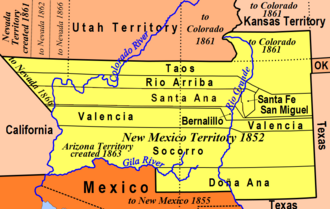
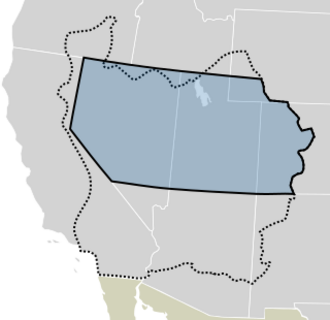
Texas was allowed to keep certain parts of the disputed land. The rest of the land was given to the United States. The final border was drawn so that El Paso stayed in Texas. However, Santa Fe became part of the New Mexico territory. The U.S. Constitution does not allow Congress to simply reduce a state's land. So, the first part of the Compromise of 1850 was an offer to the Texas State Legislature. Texas agreed to give up land in exchange for the U.S. paying its debts.
The New Mexico Territory received most of what is now Arizona and western New Mexico. It also got a part of present-day Colorado that Texas had claimed.
The Utah Territory received most of what is now Utah and Nevada, and a large part of Colorado. This included the new settlement of Salt Lake founded by Brigham Young. Utah Territory also received some land that Texas had claimed.
Fugitive Slave Act
Perhaps the most important part of the Compromise was the Fugitive Slave Act of 1850. This law made the earlier 1793 act much stronger. It required federal officials in all states and territories, even free ones, to help return escaped slaves to their owners. Any federal official who did not arrest an alleged escaped slave could be fined $1,000.
Law enforcement across the U.S. now had to arrest anyone suspected of being an escaped slave, based only on an owner's sworn statement. Suspected slaves could not have a jury trial or speak for themselves. Also, helping an escaped slave by giving food or shelter became a crime nationwide, punishable by jail time and a fine. Officials who caught an escaped slave received a fee, paid by the federal government.
This law was very unfair. It did not allow a person accused of being an escaped slave to tell their side of the story. So, free Black people could be falsely claimed as escaped slaves and sent into slavery without being able to prove they were free. Also, the officials overseeing these cases were paid more for ruling that a person was a slave ($10) than for ruling they were free ($5). This gave them a reason to rule in favor of slavery.
Many Northerners deeply disliked these parts of the law. The harsh way escaped slaves were returned made many Northerners hate the act. This increased tensions between the North and South. Writers like Harriet Beecher Stowe wrote about the horrors of recapturing escaped slaves in her famous novel, Uncle Tom's Cabin. This angered Southerners even more.
End of Slave Trade in Washington, D.C.
As part of the compromise, the slave trade was banned in Washington, D.C.. This meant enslaved people could no longer be bought and sold there. However, people could still own enslaved people in D.C. Southerners in Congress were very angry about this. They saw it as giving in to those who wanted to end slavery. But they were outvoted. People in Washington could still easily buy and sell enslaved people in nearby Virginia and Maryland.
What Happened Next
When the Compromise of 1850 passed, many people celebrated. They shouted, "The Union is saved!" President Fillmore himself called it a "final settlement" of the issues. However, the future of slavery in New Mexico and Utah was still unclear. Also, new states joining the U.S. could bring up the slavery debate again.
Not everyone accepted the Compromise. Some Southerners felt the South had lost power. Many Northerners were unhappy with the Fugitive Slave Act. The debate over slavery in the territories started again in 1854 with the Kansas–Nebraska Act. This led to more arguments throughout the 1850s, including the famous Lincoln-Douglas debates.
Looking back, the Compromise only delayed the American Civil War for about ten years. During that decade, the Whig Party fell apart. The new Republican Party became strong in the North, while Democrats controlled the South.
Some historians believe the Compromise made the differences between North and South even clearer. They see the Fugitive Slave Law as helping to divide the country, especially because of the strong reaction to Harriet Beecher Stowe's novel Uncle Tom's Cabin. The deaths of important senators like Henry Clay and Daniel Webster, who worked for compromise, also contributed to the growing divide.
The delay of the war allowed the Northern states to continue growing their industries. The Southern states, which relied heavily on enslaved labor and farming, did not industrialize as much.
Other Ideas Proposed
Before the Compromise of 1850, several other ideas were suggested for how to handle the new lands from Mexico:
- The Wilmot Proviso: This plan would have banned slavery in all new territories from Mexico. It passed the House of Representatives but not the Senate.
- Extending the Missouri Compromise Line: Some suggested extending the Missouri Compromise line (36°30' parallel north) all the way to the Pacific Ocean. This would have allowed slavery in parts of New Mexico, Arizona, and Southern California.
- Popular Sovereignty: This idea, supported by Stephen A. Douglas, suggested letting the white male residents of each territory vote on whether to allow slavery. This was later used in the Kansas–Nebraska Act and led to violence in "Bleeding Kansas".
- No Restrictions on Slavery: Some Southern leaders wanted no limits on slavery in the territories by the federal government or territorial governments before statehood.
- Two Free States: President Zachary Taylor proposed that the entire area become two large free states, California and New Mexico. This would avoid the question of slavery in territories.
- Changing Texas's Borders: Various proposals suggested different ways to draw Texas's western and northern boundaries.
- Two Southern States: One idea was to divide the southern part of the new lands into two Southern states, to balance the admission of California and New Mexico as free states.
Images for kids
-
The United States after the Treaty of Guadalupe Hidalgo, with new lands from Mexico
-
The United States Senate, A.D. 1850 (engraving by Peter F. Rothermel):
Henry Clay speaks in the Senate; Vice President Millard Fillmore is in charge. John C. Calhoun and Daniel Webster listen. -
Original proposals submitted by Clay in January 1850
-
Original proposals submitted by Clay in January 1850
-
Original proposals submitted by Clay in January 1850
-
An animation showing slave and free states and territories, 1789–1861
-
Map of New Mexico Territory in 1852
-
The Utah Territory is shown in blue. The dotted line shows the boundaries of the provisional State of Deseret.
See also
 In Spanish: Compromiso de 1850 para niños
In Spanish: Compromiso de 1850 para niños


